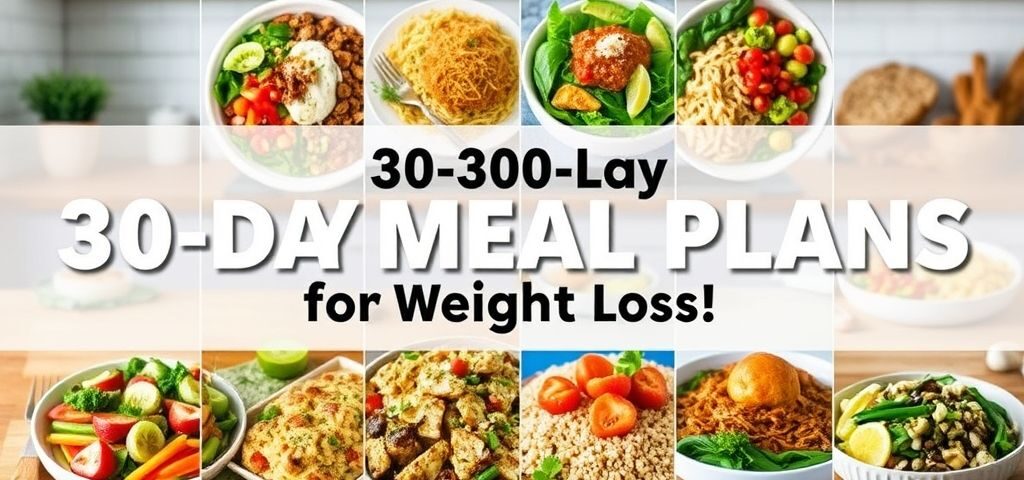Free 30-Day Meal Plan for Weight Loss
Successful weight loss isn’t about deprivation—it’s about nourishing your body with the right foods in the right balance. For women, especially, effective weight loss requires a delicate balance of nutrition, hormones, and lifestyle changes. A meal plan tailored to female physiology can help optimize metabolism, regulate hormones, preserve lean muscle, and keep you energized.
Why Female Weight Loss is Unique
Women have distinct biological and hormonal systems that affect weight loss:
Hormonal fluctuations associated with menstrual cycles can affect appetite, cravings, and water retention.
Estrogen and progesterone play roles in fat distribution and metabolism.
Lower testosterone levels in women mean less natural muscle mass, slowing resting metabolism.
Stress and cortisol levels may impact weight retention, especially around the belly.
Understanding these dynamics can help craft a meal plan that works with, not against, your body.
Calorie and Macronutrient Basics
How Many Calories Should a Woman Eat to Lose Weight?
A typical range for weight loss in moderately active women:
Sedentary: 1,200–1,400 kcal/day
Moderately active: 1,400–1,600 kcal/day
Active: 1,600–1,800 kcal/day
This plan is designed around 1,500 calories/day, which suits many women aiming for weight loss while staying energized.
Ideal Macronutrient Split
Protein: 25–30% (to preserve muscle and aid satiety)
Fats: 25–30% (for hormone production and cell health)
Carbs: 40–50% (fuel workouts and support brain function)
The Importance of Balanced Meals
Every meal in this plan includes
A lean protein source
A complex carbohydrate or fiber-rich vegetable
A healthy fat
A serving of fruit or whole grains (especially for breakfast or post-workout)
Balanced meals keep blood sugar steady, reduce cravings, and improve satiety.
Hydration and Intermittent Fasting
Hydration Tips
Drink 2.5–3 liters/day of water.
Add lemon or cucumber to make it more enjoyable.
Use herbal teas like peppermint or chamomile between meals.
Intermittent Fasting (Optional)
If you’re comfortable, consider a 16:8 fasting pattern (eat within an 8-hour window), which may boost fat burning and insulin sensitivity.
Meal Prep Tips
Plan every Sunday for the week.
Use glass containers for easy reheating.
Pre-chop veggies and cook proteins in batches.
Label meals by date for freshness.
Use spices and herbs liberally for variety.
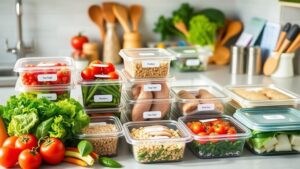
30-Day Meal Plan Overview
Meal Frequency: 3 meals + 2 snacks/day
Calories/day: ~1,500
Macronutrient Ratio: Protein: 30%, Carbs: 40%, Fats: 30%
Weekly Focus:
1WEEK: Light detox and hydration
2WEEK: Boost metabolism with protein-rich meals
3WEEK: Add more fiber and greens
4WEEK: Final tightening and rebalancing
Weekly Meal Plans
Week 1: Gentle Start (Detox & Hydration Focus)
Day 1 Example:
Breakfast: Greek yogurt with berries + chia seeds
Snack: Apple + almond butter
Lunch: Grilled chicken salad (spinach, avocado, tomato) + olive oil dressing
Snack: Carrot sticks + hummus
Dinner: Baked salmon + steamed broccoli + quinoa
Repeat a similar structure with variety. The full week’s PDF can be shared if needed.
Week 2: High-Protein Boost
Protein smoothie for breakfast
Egg muffins + veggies
Grilled turkey or tofu stir-fry
Cottage cheese + fruit
Zucchini noodles with ground beef and tomato sauce
Week 3: Fiber-Focused Detox
Overnight oats + flaxseed + blueberries
Chickpea and kale salad
Lentil soup + whole-grain crackers
Cucumber + guacamole
Stir-fried tempeh + brown rice
Week 4: Final Cut Phase
Veggie-packed omelet
Tuna and white bean salad
Protein pancakes (banana + egg + oats)
Roasted veggies + lean chicken
Low-carb wraps with turkey and avocado
Snack Ideas and Substitutions
Hard-boiled eggs
Cottage cheese + pineapple
Protein bars (low sugar)
Veggie sticks + tzatziki
Rice cakes + peanut butter
Supplements and Superfoods
These are optional but can enhance results:
Multivitamins
Magnesium and Vitamin D
Whey or vegan protein powder
Greens powder
Chia seeds, flaxseeds, maca, spirulina
Weight loss isn’t about perfection—it’s about consistency. This free 30-day meal plan empowers you to eat nourishing, delicious food while steadily progressing toward your goals. Adapt, stay positive, and celebrate every small victory.
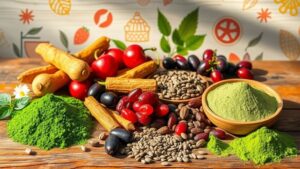
Will This Meal Plan Help With Bloating?
Bloating can be uncomfortable, frustrating, and even embarrassing. It often sneaks up after meals, disrupts your day, and can make you feel like your weight loss efforts are going nowhere. But the good news? The right meal plan can significantly reduce bloating, and this guide will show you exactly how.
Understanding Bloating
Bloating is that unpleasant feeling of fullness, tightness, or swelling in your abdomen. Sometimes your belly may even look visibly larger. It’s often confused with water retention or fat gain, but it’s primarily a digestive issue.
What’s Happening?
Gas builds up in your intestines due to undigested food or bacterial imbalance.
The gut may slow down, causing delayed emptying (called gastroparesis).
The body may retain water due to sodium or hormonal changes.
This leads to a bloated, distended feeling that can last hours—or even days.
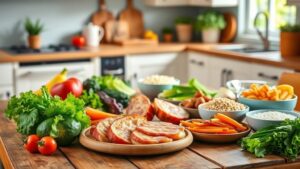
Common Causes of Bloating in Women
Bloating can be a daily struggle for women, especially due to hormonal fluctuations and gut sensitivity. Here’s what commonly causes it:
PMS and Hormonal Changes: Estrogen and progesterone shifts affect water retention and digestion.
High-Sodium Diet: Salt pulls water into your tissues, leading to puffiness.
Constipation: Trapped stool equals trapped gas.
Food Intolerances: Lactose, gluten, FODMAPs, and artificial sweeteners are frequent culprits.
Processed Foods: Low fiber and high sugar delay digestion.
Eating Too Fast: Swallowing air while eating causes gas buildup.
Can a Meal Plan Reduce Bloating?
Absolutely. A strategic, bloat-friendly meal plan focuses on:
Whole, natural foods
Low-FODMAP ingredients (which reduce fermentable carbs)
Anti-inflammatory herbs and spices
Proper food timing
Hydration and fiber balance
By eliminating known triggers and boosting gut-friendly nutrients, you can see visible results in just a few days.
Top Foods to Eat to Beat Bloating
Here’s what to include in your meal plan:
Cucumber
High in water and contains quercetin, a flavonoid that reduces inflammation.
Ginger
Soothes the digestive tract, reduces inflammation, and stimulates motility.
Pineapple
Bromelain, a natural enzyme found in pineapple, helps ease digestion by breaking down protein molecules into smaller, more absorbable components. Free 30-Day Meal Plan for Weight Loss
Bananas
Rich in potassium, which balances sodium and prevents water retention.
Avocados
High in potassium and healthy fats, supporting hormone balance and digestion.
Fennel Seeds
Known for reducing gas and cramping.
7. Yogurt with Probiotics
Promotes good gut bacteria and reduces bloating caused by dysbiosis.
8. Oats
Soluble fiber helps regulate digestion without irritating your gut.
Foods That Cause or Worsen Bloating
Avoid or limit these for best results:
High-FODMAP Foods:
Onions, garlic, beans, lentils, cauliflower, apples, pears
Carbonated Drinks:
Sodas and sparkling water introduce air into your gut
Artificial Sweeteners:
Sorbitol and xylitol ferment in your intestines
Fried and Greasy Foods:
Harder to digest and slows down gut motility
Dairy:
Especially if you’re lactose intolerant
Gluten:
Can trigger bloating in those with sensitivity or intolerance
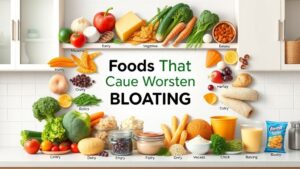
Sample 3-Day Anti-Bloat Meal Plan
This plan includes easy-to-digest, anti-inflammatory, and fiber-balanced meals.
Day 1
Breakfast: Overnight oats with chia, blueberries, and almond milk
Snack: Cucumber slices with hummus
Lunch: Grilled chicken, quinoa, and steamed zucchini
Snack: Pineapple chunks + mint tea
Dinner: Baked salmon with sautéed spinach and sweet potato
Day 2
Breakfast: Banana smoothie with ginger, spinach, and protein powder
Snack: Yogurt with ground flaxseeds
Lunch: Turkey lettuce wraps with avocado and shredded carrots
Snack: Papaya slices
Dinner: Stir-fried tofu with rice noodles and bok choy
Day 3
Breakfast: Oatmeal with cinnamon and strawberries
Snack: Boiled egg + cucumber water
Lunch: Quinoa tabbouleh with grilled shrimp
Snack: Peppermint tea + a few almonds
Dinner: Zucchini noodles with pesto and grilled chicken
Lifestyle Tips for Long-Term Relief
Your diet is crucial, but how you eat and live also play a major role.
1. Chew Thoroughly
Helps break down food before it hits your gut.
2. Eat Slower
Reduces air intake and improves digestion.
3. Walk After Meals
Even a 10-minute stroll helps prevent food stagnation.
4. Avoid Talking While Eating
Prevents you from swallowing air.
5. Track Your Triggers
Keep a journal to identify which foods bloat you the most.
Best Supplements for Bloating
Supplements can be powerful allies when used correctly:
1. Digestive Enzymes
Help break down proteins, carbs, and fats more efficiently.
2. Probiotics
Restore gut flora balance, especially after antibiotics or a poor diet.
3. Magnesium Citrate
Supports regular bowel movements.
4. Activated Charcoal
Absorbs gas, but should be used for short-term oil
Bloating vs. Fat: Know the Difference
Bloating:
Sudden
Comes and goes
Belly feels tight or painful
Often improves with a bathroom trip or gas release
Fat:
Accumulates gradually
Doesn’t fluctuate daily
Soft and persistent
Won’t go away with a probiotic or tea
Conclusion
Bloating isn’t just a cosmetic concern—it’s a sign that your digestive system may need support. The right anti-bloat meal plan filled with natural, soothing foods and balanced nutrients can provide real relief.
Remember:
-
Prioritize whole, low-FODMAP foods
-
Stay hydrated
-
Eat slowly and mindfully
-
Track and avoid your triggers
Within just a few days, you’ll feel lighter, more comfortable, and more confident in your body.
FAQs
Can a meal plan reduce bloating fast?
Yes! Many women experience relief within 2–3 days by removing inflammatory and fermentable foods.
What is the fastest way to get rid of bloating?
Hydration + peppermint tea + low-FODMAP meals + a walk = fast relief.
Should I avoid carbs to reduce bloating?
Not all carbs. Stick with low-FODMAP, high-fiber options like oats, quinoa, and sweet potatoes.
Can I follow this plan if I’m vegan or vegetarian?
Yes! Swap animal proteins with tofu, tempeh, lentils, chickpeas, seitan, or vegan protein powder. I can provide a plant-based version.
Will I feel hungry on 1,500 calories?
You might in the first few days, but meals are rich in fiber and protein to keep you full. Drink plenty of water and avoid empty-calorie snacks.
Can I work out on this plan?
Absolutely. Pair this meal plan with 30–45 minutes of moderate activity 4–5 times/week for best results.

